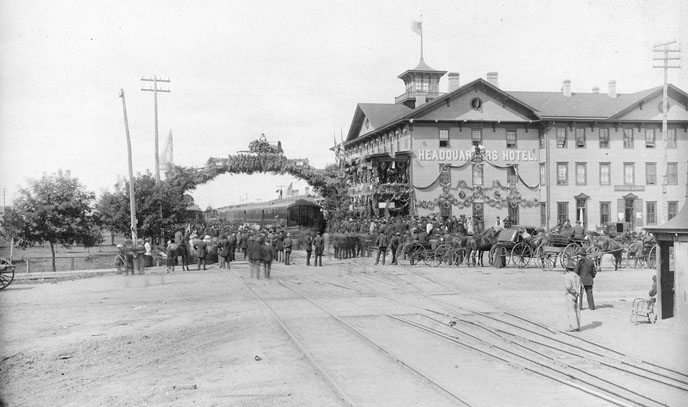Northern Pacific Golden Spike Excursion

On May 10, 1869, the country's first transcontinental railroad was completed when the Central Pacific and Union Pacific Railroads met in Brigham City, Utah. The Last Spike, also known as the Gold Spike, was the final link in the forming of the first transcontinental railroad in the United States. It was tapped into a prepared hole by Leland Stanford on May 10, 1869, at a ceremony joining the Central Pacific and Union Pacific rails. Governor Stanford drove the Last Spike into a polished California laurel tie before an audience of some 3,000 government and railroad officials and track workers in the desert at Promontory, Utah.
The Northern Pacific Railroad held a similar ceremony.
In 1873, there was a financial panic and construction on the Northern Pacific Railroad halted. The line had only gotten as far as Bismarck, North Dakota. The company was bankrupt and had to be reorganized. In 1876-77, finances improved. In 1879, Frederick Billings took over as president. Things were finally looking up when Henry Villard stepped in. He had been president of the Oregon Railway & Navigation Company, the most successful transportation company in the country. He had a huge fleet of steamboats and connecting portage railroads. They had a main line along the south bank of the Columbia and had planned feeder lines in eastern Washington and Oregon. The area was his and he planned to keep it that way. On October 20, 1880, an agreement was reached whereby the Northern Pacific would use his rails on the south bank until they could build their own line. He wanted to make this arrangement permanent. But he soon realized that complete control of the Northern Pacific would be the only satisfactory arrangement. He and his wealthy friends bought controlling interest in the Northern Pacific.
By 1882 there was still 900 miles of track left to be laid between Glendive, Montana, and Ritzville, Washington. On the western end, thousands of Chinese were bought in as laborers. Mormons from Utah were subcontracted to grade. Veteran Swedes and Irish were hired on the eastern end. Between September 1881 and August 1883, the gangs laid about a mile and a half per day.
On August 23, 1883 the east and west crews met at Hell Gate Canyon 55 miles west of Helena. A golden spike ceremony was held on September 8 at Gold Creek, Montana. The last spike was not actually golden, but was the first spike drilled in at Thomsons Junction, Minnesota. It was hammered by Mr. Davis, who had drilled the same spike in Minnesota.
Labeled the "Villard 'Golden Spike' Excursion", the F. J. Haynes photograph above depicts the special decorations and ceremonies held in Fargo as the train passed through on its way to the ceremony. The second Headquarters Hotel is clearly pictured.
This photograph is from the State Historical Society of North Dakota Museum Collection C0870.

This picture shows the band stand in NP Park (south of the NP tracks across from the Headquarters Hotel) decorated for the Golden Spike excursion.
This photograph is from the State Historical Society of North Dakota Museum Collection A0172.
